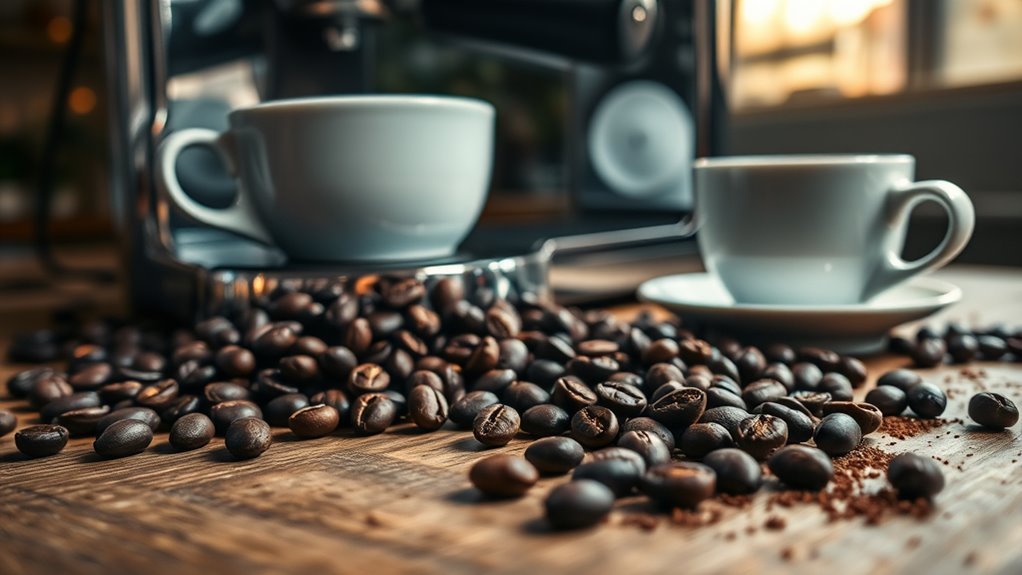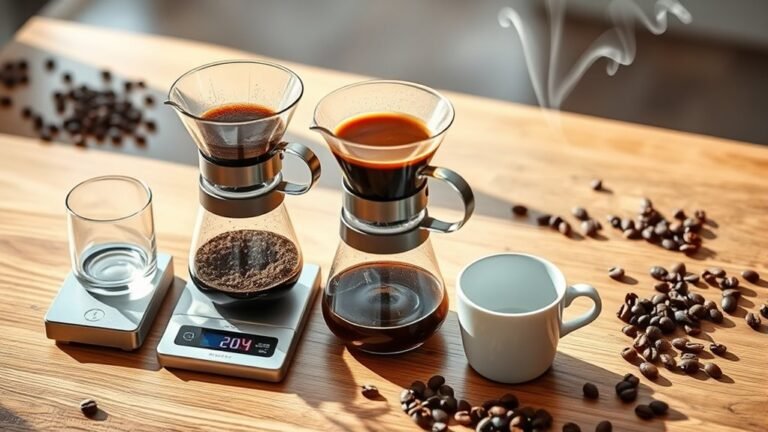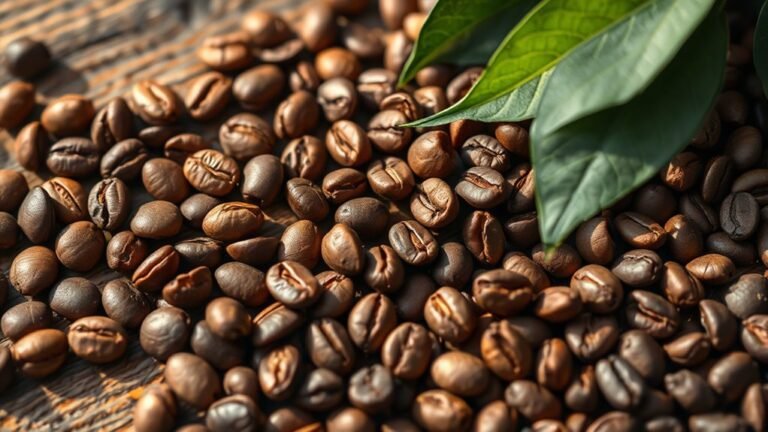Can I Use Regular Coffee Beans for Espresso
You can use regular coffee beans for espresso, but it may alter the flavor profile and extraction process. Regular beans might lack the complexity and freshness needed for the rich taste associated with espresso. Additionally, the grind size and roast level play vital roles in flavor extraction. While it’s possible to experiment, the results may not meet your expectations. By exploring the nuances of grind size and roast levels, you’ll discover how to enhance your espresso experience.
Understanding Espresso vs. Regular Coffee
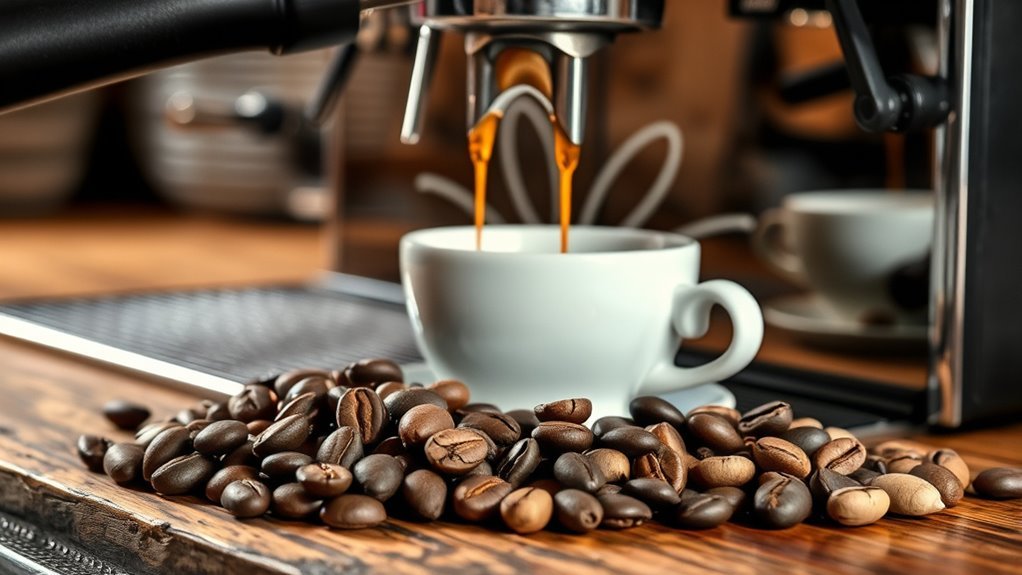
When you explore the world of coffee, it’s essential to understand the differences between espresso and regular coffee, as these two brewing methods yield distinct flavors and experiences. Espresso characteristics are defined by its concentrated flavor, thick crema, and rich body, achieved through high pressure during extraction. This method uses finely ground coffee, typically from specific coffee origins known for their bold profiles. In contrast, regular coffee offers a lighter, more diluted taste due to standard brewing techniques like drip or pour-over, which utilize coarser grounds. Understanding these differences allows you to appreciate the unique qualities of each brew and choose the right method to suit your personal preferences. Ultimately, your coffee journey hinges on these essential distinctions.
The Role of Grind Size in Brewing
Grind size plays a vital role in brewing, particularly when comparing espresso to regular coffee. A finer grind is essential for espresso, as it enhances flavor extraction and creates the desired crema. Understanding this difference can greatly impact your brewing results and overall coffee experience.
Importance of Grind Size
Although many factors influence the quality of your espresso, the grind size of your coffee beans plays an essential role in the brewing process. Achieving grind uniformity is important for consistent extraction efficiency. If your grind size varies, some particles will over-extract, while others may under-extract, leading to an imbalanced flavor profile. A finer grind typically allows for a quicker extraction, which is significant for espresso, where water passes through the coffee under pressure. If you’re using regular coffee beans, pay close attention to how finely you grind them. A precise grind size can enhance the rich, bold flavors you desire, ensuring each shot of espresso reflects your brewing intentions. Ultimately, the right grind size empowers your espresso experience.
Espresso vs. Regular Grind
The distinction between espresso grind and regular grind is essential for achieving the desired flavor profile in your coffee. Espresso preparation requires a much finer grind compared to regular coffee. This fine grind increases the surface area, allowing for a faster extraction during brewing methods like espresso machines. If you use a regular grind, the extraction will be uneven, leading to underwhelming flavors and a lack of intensity. Additionally, brewing methods that rely on pressure, such as espresso, need that fine consistency to create the rich crema and robust taste you expect. So, when considering your coffee choice, remember that the grind size directly influences the overall quality of your espresso experience.
Impact on Flavor Extraction
When it comes to brewing coffee, the size of the coffee particles greatly impacts flavor extraction. A finer grind allows for a quicker extraction time, which can enhance certain flavors, but if you’re using regular coffee beans instead of espresso beans, you might not achieve the desired flavor balance. Coarser grinds, common with regular beans, tend to slow down the extraction, leading to under-extraction. This could result in a more acidic and less complex flavor profile, lacking the richness of a well-crafted espresso. Ultimately, adjusting your grind size according to the beans you’re using is essential. Experimenting with grind size will help you discover the best extraction time for the flavors you want to highlight in your cup.
Roast Levels: Light, Medium, and Dark
While many people associate espresso exclusively with dark roast coffee, understanding the differences in roast levels—light, medium, and dark—can greatly enhance your brewing experience. Light roast beans maintain more of their natural flavors, offering a bright acidity and complex notes. They also have a higher caffeine content, which some coffee enthusiasts appreciate. Medium roast strikes a balance, providing a rounded flavor profile that appeals to many drinkers. On the other hand, dark roast beans are known for their bold, robust taste, often accompanied by a lower acidity. While dark roast is commonly used for espresso, experimenting with light or medium roasts can yield unique results, allowing you to tailor your espresso to your personal taste preferences.
Flavor Profiles: What to Expect
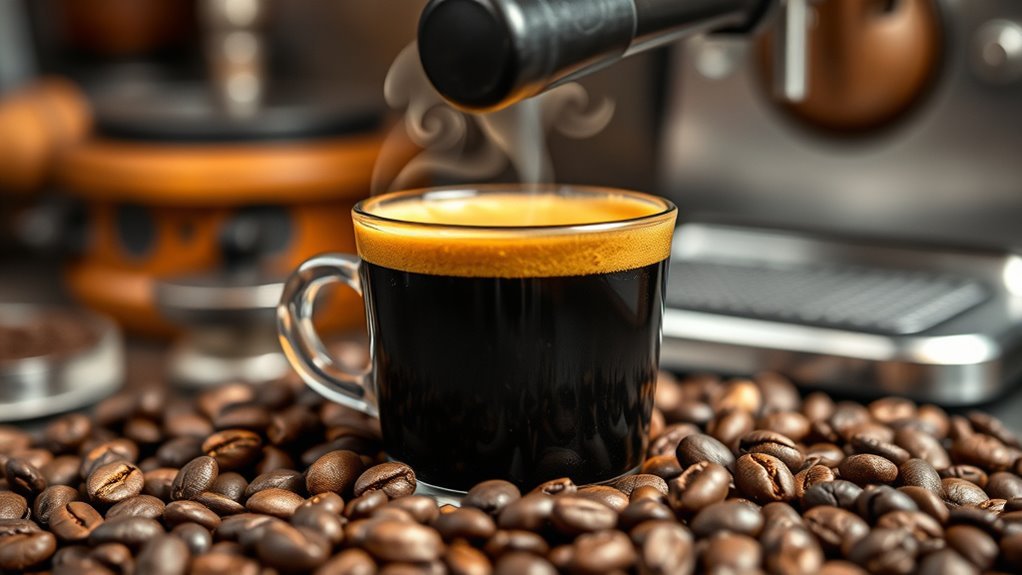
How do different roast levels impact the flavor profiles of espresso? When you choose regular coffee beans, the roast level greatly influences the resulting flavor nuances. Light roasts often present bright acidity and floral or fruity tasting notes, making for a vibrant espresso. Medium roasts strike a balance, offering a mix of sweetness and mild acidity, resulting in well-rounded flavors. Dark roasts, on the other hand, deliver bold, chocolatey notes with a heavier body, sometimes masking subtle complexities. Each roast level shapes the espresso’s overall character, affecting your tasting experience. By understanding these profiles, you can explore a wider range of flavors and find the perfect espresso that resonates with your palate and freedom of choice.
The Brewing Process: Equipment and Technique
Although the brewing process can seem straightforward, the right equipment and technique are vital for extracting the best flavors from regular coffee beans when making espresso. Here are three key brewing techniques to take into account:
- Espresso Machines: Invest in a quality espresso machine that can deliver consistent pressure and temperature. This is critical for ideal extraction.
- Grind Size: Use a fine grind for your regular coffee beans. This increases surface area and enhances flavor extraction during brewing.
- Water Temperature: Aim for a water temperature between 190°F and 205°F. This range allows for the best flavor compounds to be released without risking bitterness.
Making the Best Choice for Your Espresso Experience
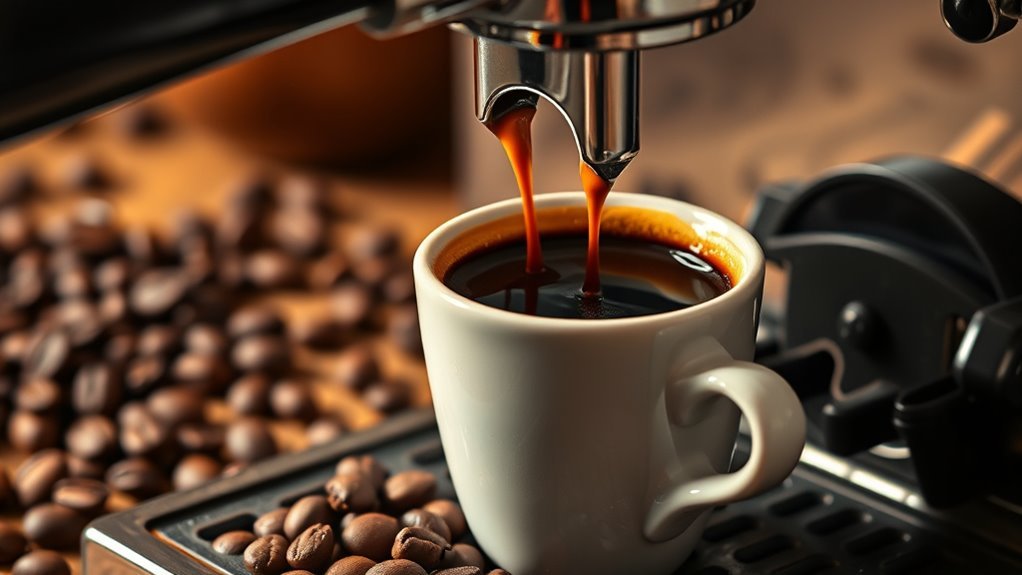
When choosing beans for your espresso, the variety can markedly impact flavor and aroma. You’ll also want to pay close attention to grind size, as it affects extraction and can make or break your shot. Together, these factors are key to enhancing your overall espresso experience.
Bean Variety Matters
Selecting the right bean variety is essential for crafting an espresso that suits your taste preferences and elevates your coffee experience. The choice of bean origin greatly influences the flavor characteristics of your brew. Here are three factors to evaluate when selecting your beans:
- Bean Origin: Different regions produce unique flavor profiles; for example, Ethiopian beans often have fruity notes, while Brazilian beans may offer chocolatey undertones.
- Arabica vs. Robusta: Arabica beans are generally sweeter and more complex, while Robusta beans provide a stronger, more bitter flavor and higher caffeine content.
- Processing Method: How beans are processed can enhance or alter their inherent flavors, affecting acidity and body.
Understanding these factors helps you make an informed choice, ensuring a satisfying espresso experience.
Grind Size Importance
The right grind size is essential for achieving the perfect espresso extraction, as it directly affects the flow rate of water through the coffee grounds. For your espresso machine to perform at its best, you need a fine grind with consistent particle size. Inconsistent grind size can lead to uneven extraction, resulting in bitter or sour flavors. Aim for a uniform texture to guarantee that water saturates the grounds evenly, allowing for a balanced shot. Remember, finer grinds increase resistance, affecting the brewing time and pressure. Experimenting within the fine grind range can help you find the ideal consistency for your preferred espresso. This attention to grind size can dramatically elevate your espresso experience, giving you the freedom to enjoy nuanced flavors.
Frequently Asked Questions
Can I Mix Regular Coffee Beans With Espresso Beans?
Mixing regular coffee beans with espresso beans can yield interesting results, but it’s essential to take into account bean compatibility. Espresso blends are specifically crafted for ideal extraction under pressure, while regular beans may not have the same flavor profile. You might enjoy experimenting with ratios to find a blend that suits your taste. Just remember, the key is balance; too much of one type could overpower the other, so adjust carefully to achieve your desired flavor.
Will Using Regular Beans Affect Crema Quality?
Using regular beans can definitely impact crema consistency. You’ll notice that the roast level plays an essential role; darker roasts often yield better crema due to the oils released during the roasting process. If you’re using a lighter roast, you might find the crema lacking in richness and stability. So, while you can experiment, keep in mind that the quality and roast of your beans are key to achieving that perfect espresso experience.
How Fresh Should Regular Coffee Beans Be for Espresso?
For ideal espresso, the freshness of your regular coffee beans is essential. Ideally, they should be used within two to four weeks of roasting. Freshness impacts flavor and crema quality, enhancing your espresso experience. The roast levels also matter; lighter roasts may lose their nuances faster, while darker roasts can maintain flavor longer. By selecting fresh beans and considering roast levels, you can guarantee a rich and satisfying espresso.
Can I Use Flavored Regular Coffee Beans for Espresso?
When it comes to using flavored regular coffee beans for espresso, it’s a double-edged sword. While they can add unique twists to your espresso flavor, the intensity of the flavors might not shine through as you’d expect. Espresso typically requires a bold, concentrated taste, and flavored beans may dilute that. If you’re looking to experiment, go ahead, but keep in mind that the core essence of espresso could get lost in the mix.
Are There Specific Brands of Regular Beans Recommended for Espresso?
When selecting regular coffee beans for espresso, you’ll want to focus on dark roast and medium roast options. Dark roasts offer bold flavors and a rich crema, while medium roasts provide a balanced taste profile with some acidity. Brands like Peet’s Coffee and Intelligentsia are often recommended due to their quality options in these roast levels. Experimenting with different brands can help you find the perfect fit for your espresso preferences.
